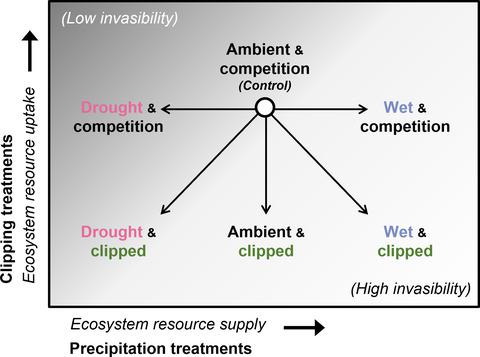Our official English website, www.x-mol.net, welcomes your
feedback! (Note: you will need to create a separate account there.)
Demographic analysis of invasible habitat fraction identifies context‐dependent roles of resource availability and biotic resistance in determining invasion success
Journal of Ecology ( IF 5.3 ) Pub Date : 2020-09-16 , DOI: 10.1111/1365-2745.13498 Alden B. Griffith 1 , Vikki L. Rodgers 2 , Jeffrey S. Dukes 3, 4, 5
中文翻译:

侵略性生境部分的人口统计分析确定了资源可利用性和生物抗性在确定入侵成功与否方面的背景相关作用
更新日期:2020-09-16
Journal of Ecology ( IF 5.3 ) Pub Date : 2020-09-16 , DOI: 10.1111/1365-2745.13498 Alden B. Griffith 1 , Vikki L. Rodgers 2 , Jeffrey S. Dukes 3, 4, 5
Affiliation

|
- Theories of plant invasions predict that plant communities should be more easily invaded when resources increase and/or competition decreases. We tested this with an experimentally introduced plant population by manipulating precipitation and resident community biomass. We used a spatially explicit demographic approach to develop a new population‐level metric of invasibility that quantifies the invasible habitat fraction (IHF) across the landscape.
- The existing community was essentially uninvasible (median IHF ≈ 0%), but experimental manipulations greatly increased the range of outcomes, with maximum observed IHF values over 50%. However, changes in invasibility were often context‐dependent, resulting in some outcomes that aligned with existing theory, and others that were not readily predicted. Moreover, variation in invasibility was often driven by specific sets of invader demographic vital rates.
- Removing competitors revealed the capacity for strong biotic resistance, but this interacted with precipitation such that little biotic resistance was detected under drought conditions. Adding precipitation typically had little positive effect on invasibility, and moderate drought relief led to relatively high invasibility. However, the latter was driven to a large extent by interactions with mammal herbivory that otherwise inhibited invasion in one year.
- Synthesis. Our findings show that interactions between abiotic and biotic factors, as well as legacy effects, can strongly mediate invasibility. This study also highlights the importance of incorporating spatial heterogeneity into population‐level assessments of invasion, as initial population declines do not necessarily indicate resistance to invasion.
中文翻译:

侵略性生境部分的人口统计分析确定了资源可利用性和生物抗性在确定入侵成功与否方面的背景相关作用
- 植物入侵的理论预测,当资源增加和/或竞争减少时,植物群落应该更容易受到入侵。我们通过控制降水量和居民社区生物量,通过实验引入的植物种群对此进行了测试。我们使用空间上明确的人口统计方法,开发了一种新的种群级可入侵性指标,该指标可量化整个景观中的可入侵栖息地比例(IHF)。
- 现有的社区基本上是无创的(中位数IHF≈0%),但是实验操作大大增加了结果范围,最大观察到的IHF值超过50%。但是,入侵性的变化通常取决于上下文,导致某些结果与现有理论一致,而另一些则不容易预测。此外,侵害力的变化通常是由特定的侵略者人口统计生命率集合驱动的。
- 淘汰竞争对手显示出了强大的生物抗性的能力,但这与降水相互作用,因此在干旱条件下几乎没有发现生物抗性。增加降水通常对入侵性几乎没有积极影响,适度的干旱缓解导致相对较高的入侵性。但是,后者在很大程度上是由于与哺乳动物食草动物的相互作用而驱使的,否则它们会在一年内抑制入侵。
- 综合。我们的发现表明,非生物和生物因素之间的相互作用以及遗留效应可以强烈介导入侵性。这项研究还强调了将空间异质性纳入人口水平的入侵评估中的重要性,因为初始种群下降并不一定表明对入侵具有抵抗力。











































 京公网安备 11010802027423号
京公网安备 11010802027423号